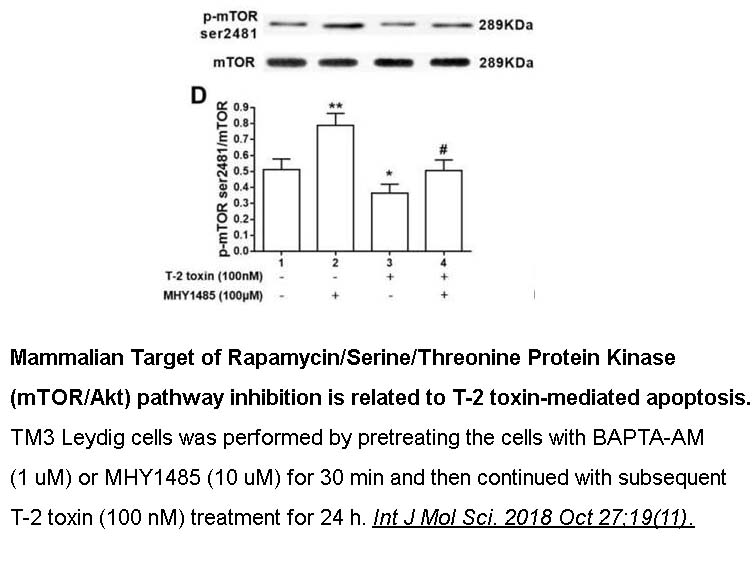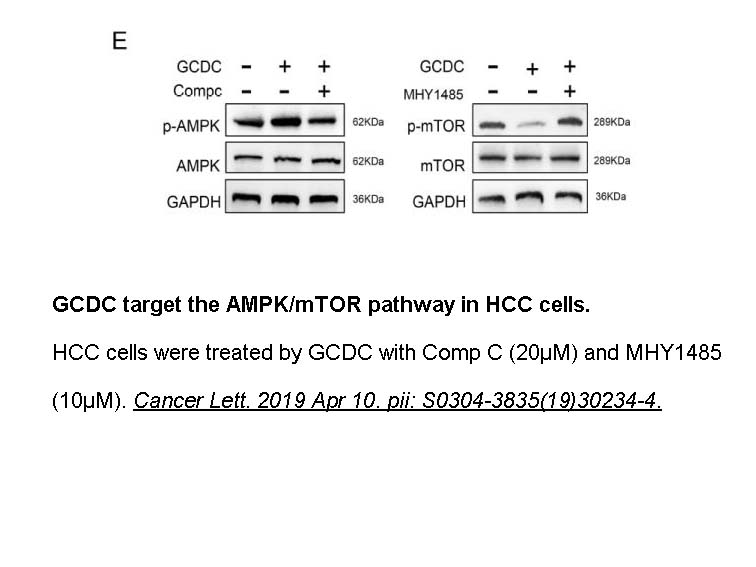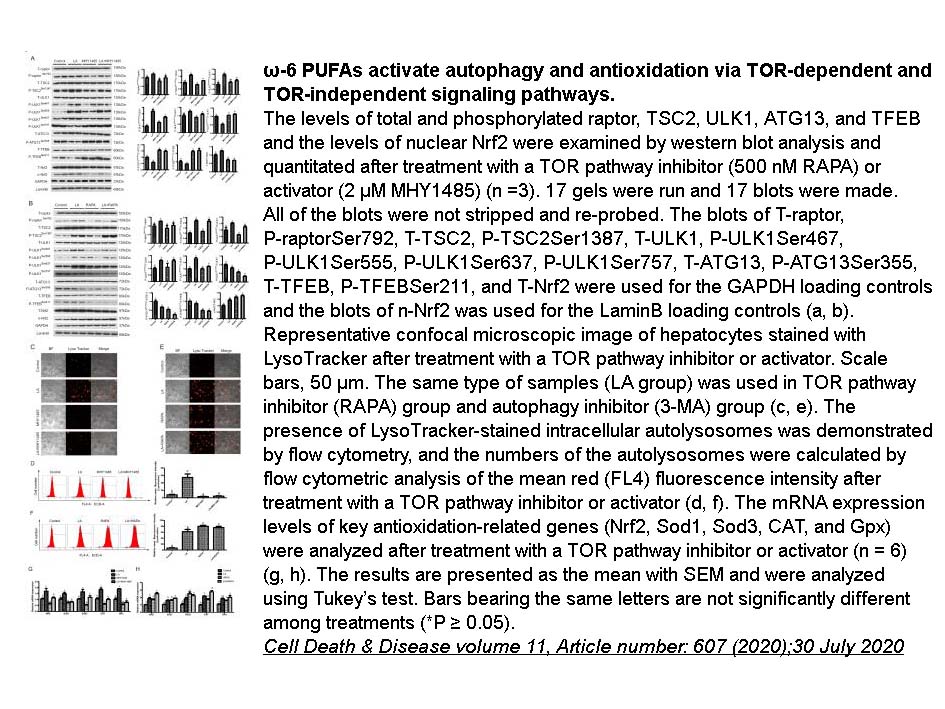MHY1485
MHY1485 is a potent mTOR activator that inhibits autophagy with suppression of fusion between autophagosomes and lysosomes. [1]
mTOR (mechanistic target of rapamycin) is a serine/threonine kinase that regulates cellular metabolism, growth ad survival. It mediates the cellular response to stress, growth factor and hormone etc. Inhibition of mTOR strongly induced autophagy. mTOR signaling also plays a role in the promotion of ovarian follicle development.
In Ac2F rat hepatocytes, MHY1485 treatment suppresses the basal autophagic flux, and it also shows inhibitory effect under cell starvation which is an inducer of autophagy. The effects of MHY1485 dose-and time- dependently cause accumulation of LC3II and enlargement of the autophagosomes. [1]
Ovaries of juvenile mice cultured with MHY1485 for 4 days increases ovarian explant weights and follicle development. 2 days pre-incubation of these ovaries with MHY1485 followed by allo-grafting into kidney capsules of adult ovariectomized hosts for 5 days, shows apparent increases in graft weights and promotion of follicle development. [2]
References:
1, Choi YJ, Park YJ, Park JY et al. Inhibitory effect of mTOR activator MHY1485 on autophagy: suppression of lysosomal fusion. PLoS One. 2012;7(8):e43418. doi:10. 1371/journal.pone.0043418. Epub 2012 Aug 22. Erratum in: PLoS One. 2013;8(1).
2, Cheng Y, Kim J, Li XX, Hsueh AJ. Promotion of ovarian follicle growth following mTOR activation: synergistic effects of AKT stimulators. PLoS One. 2015 Feb 24;10(2):e0117769.
- 1. Molly E. Drosen, Sarojini Bulbule, et al. "Inactivation of ATG13 stimulates chronic demyelinating pathologies in muscle-serving nerves and spinal cord." Immunol Res. 2025 Jan 7;73(1):27 PMID: 39777574
- 2. Yu Bian, Han Wu, et al. "Anti-b diminishes hyperlipidaemia and hepatic steatosis in hamsters and mice by suppressing the mTOR/PPARγ and mTOR/SREBP1 signalling pathways." British Journal of Pharmacology 29 November 2024
- 3. Meng Liu, Li He, et al. "Dietary cysteine and methionine promote peroxisome elevation and fat loss by induction of CG33474 expression in Drosophila adipose tissue." Cell Mol Life Sci. 2024 Apr 22;81(1):190. PMID: 38649521
- 4. Zhending Gan, Yan Guo, et al. "Excitatory amino acid transporter supports inflammatory macrophage responses." Sci Bull (Beijing). 2024 Aug 15;69(15):2405-2419. PMID: 38614854
- 5. Tingting Wei, Na Liu, et al. "Low-dose cadmium telluride quantum dots trigger M1 polarization in macrophages through mTOR-mediated transcription factor EB activation." NanoImpact. 2024 Apr:34:100505. PMID: 38579989
- 6. Feng Hu, et al. "TRPM2 knockdown attenuates myocardial apoptosis and promotes autophagy in HFD/STZ-induced diabetic mice via regulating the MEK/ERK and mTORC1 signaling pathway." Mol Cell Biochem. 2024 Feb 3. PMID: 38308007
- 7. Zhiqiang Dai, Yang Zeng, et al. "3-Hydroxy-3-methylglutaryl-CoA synthase 2 facilitates erectile dysfunction via inhibiting autophagy by enhancing the mammalian target of rapamycin pathway in type 1 diabetic mellitus rats." Andrology. 2024 Jan 25. PMID: 38273709
- 8. Liu B, Yao X, et al. "LINC01278 Induces Autophagy to Inhibit Tumour Progression by Suppressing the mTOR Signalling Pathway." Oxid Med Cell Longev 2023;2023. PMID: 36713034
- 9. Bo Yang, Yan Zhou, et al. "ω-6 Polyunsaturated fatty acids (linoleic acid) activate both autophagy and antioxidation in a synergistic feedback loop via TOR-dependent and TOR-independent signaling pathways." Cell Death Dis. 2020 Jul 30;11(7):607. PMID:32732901
- 10. Huang Z, Mou T, et al. "Inhibition of miR-450b-5p ameliorates hepatic ischemia/reperfusion injury via targeting CRYAB." Cell Death Dis. 2020;11(6):455. PMID:32532961
- 11. Gao L, Lv G, et al. "Glycochenodeoxycholate promotes hepatocellular carcinoma invasion and migration by AMPK/mTOR dependent autophagy activation." Cancer Lett. 2019 Jul 10;454:215-223. PMID:30980867
- 12. Wang J, Yang C, et al. "T-2 Toxin Exposure Induces Apoptosis in TM3 Cells by Inhibiting Mammalian Target of Rapamycin/Serine/Threonine Protein Kinase(mTORC2/AKT) to Promote Ca(2+)Production." Int J Mol Sci. 2018 Oct 27;19(11). pii: E3360. PMID:30373220
| Physical Appearance | A solid |
| Storage | Store at -20°C |
| M.Wt | 387.39 |
| Cas No. | 326914-06-1 |
| Formula | C17H21N7O4 |
| Solubility | insoluble in EtOH; insoluble in H2O; ≥19.35 mg/mL in DMSO |
| Chemical Name | 4,6-dimorpholino-N-(4-nitrophenyl)-1,3,5-triazin-2-amine |
| SDF | Download SDF |
| Canonical SMILES | [O-][N+](C1=CC=C(NC2=NC(N3CCOCC3)=NC(N4CCOCC4)=N2)C=C1)=O |
| Shipping Condition | Small Molecules with Blue Ice, Modified Nucleotides with Dry Ice. |
| General tips | We do not recommend long-term storage for the solution, please use it up soon. |
| Cell experiment [1]: | |
|
Cell lines |
Ac2F cells |
|
Preparation method |
The solubility of this compound in DMSO is > 19.4 mg/mL. General tips for obtaining a higher concentration: Please warm the tube at 37 °C for 10 minutes and/or shake it in the ultrasonic bath for a while. Stock solution can be stored below - 20 °C for several months. |
|
Reacting condition |
2 μM; 6 hrs |
|
Applications |
Under starvation, LC3 and lysosomal signal overlap in Ac2F cells transfected with AdGFP-LC3 and stained with LysoTracker (for visualization of lysosomes) was decreased by MHY1485. Thus, MHY1485 inhibited starvation-induced fusion between autophagosomes and lysosomes. |
|
References: [1]. Choi YJ, Park YJ, Park JY, Jeong HO, Kim DH, Ha YM, Kim JM, Song YM, Heo HS, Yu BP, Chun P, Moon HR, Chung HY. Inhibitory effect of mTOR activator MHY1485 on autophagy: suppression of lysosomal fusion. PLoS One. 2012;7(8):e43418. |
|
Quality Control & MSDS
- View current batch:
Chemical structure

Related Biological Data

Related Biological Data

Related Biological Data

Related Biological Data








